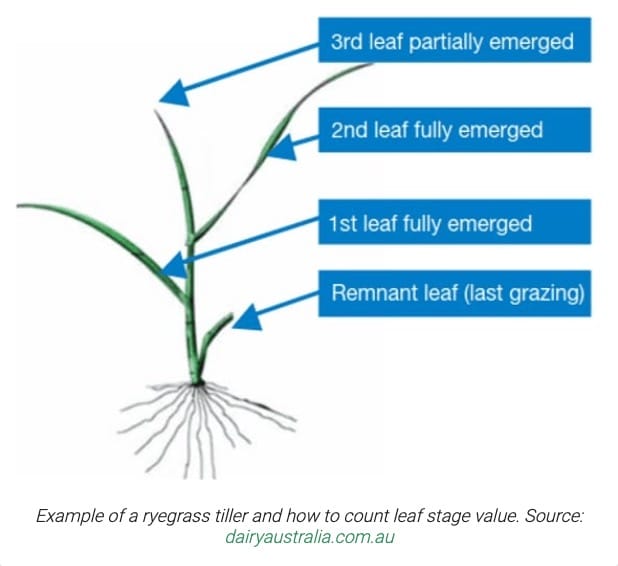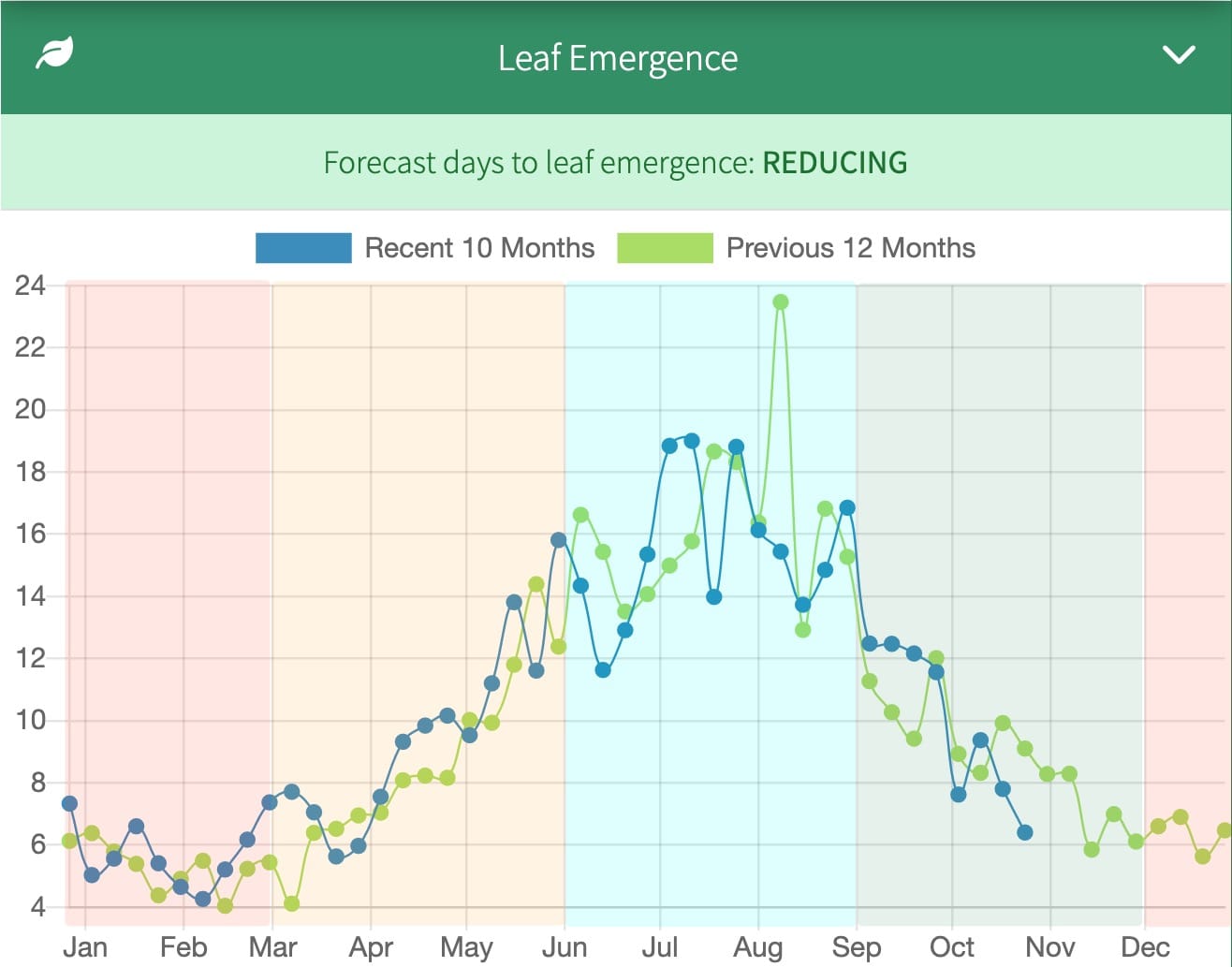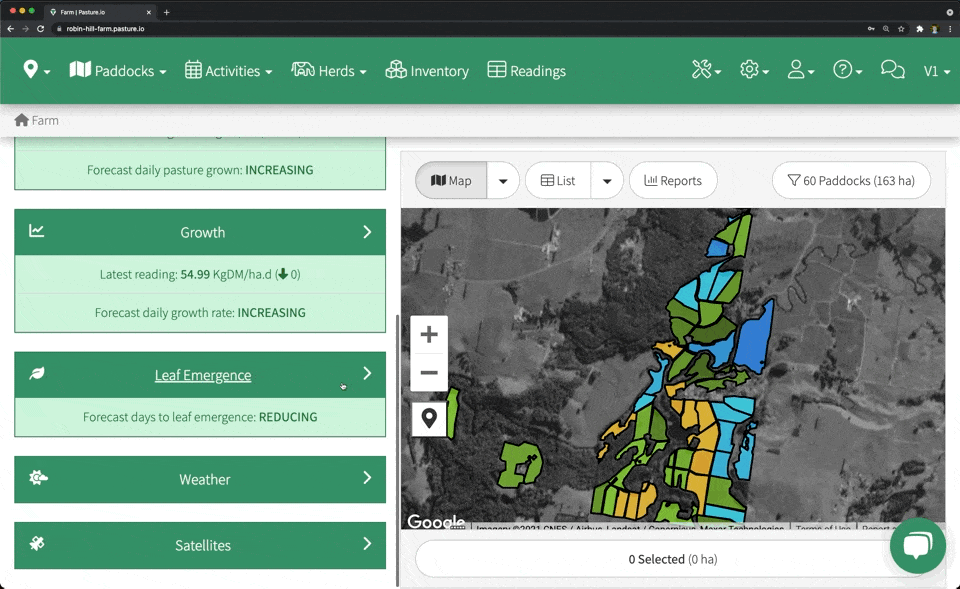Article Summary:
In this article, we’re going to discuss the easiest way to use the leaf stage of your pastures for maximising quantity and quality without going out into the paddock and counting leaves.
- Why is the leaf stage practical?
- How to maximise the quantity of ryegrass pastures with the leaf stage?
- How to maximise the quality of ryegrass pastures with the leaf stage?
- What are the recommended leaf stage targets at varying times of the year?
- How do I measure the pasture leaf stage without stepping into the paddock?
When it comes to pasture fundamentals, understanding the leaf stage is imperative to successful grazing.
It is all about counting the number of leaves that have appeared or emerged and then understanding your round length based on your target leaf stage at grazing.
In this article, we’re going to discuss the easiest way to use the leaf stage of your pastures for maximising quantity and quality without going out into the paddock and counting leaves.

Why is the leaf stage practical?
Well, it can give you a snapshot of what's going on in your pasture and help you choose the best speed for your grazing rotations.
In other words, you can set your grazing rotation speed based on the leaf appearance rate of your pastures.
Of course, this is all else being equal such as stocking rates and other demands on the grazing platform, but that is for another article.
Today is about the leaf stage, which understanding this will help you graze your pastures at the optimum time for:
- Optimising the quality of pasture by not grazing prematurely or too late can lead to varying levels of fibre, protein, and energy during the different leaf stages.
- The next point is for maximising the quantity of pasture by not grazing prematurely when the plant has not had enough time to restore energy in the roots or not grazing too late when decay from canopy closure or the final leaf has fully emerged.
So it's simple.
You want to graze at the leaf stage that optimises both pasture quality and quantity.
Balancing the quality vs quantity of the pasture is an ongoing challenge and changes seasonally, depending on the time of year.
It can all sound a little complicated, but honestly, we have a tool that counts the leaves for you, and I'll talk about this a little later in the article.
First, let's use ryegrass as an example.
If you're interested in other species, we'll touch on these later in the article.

How to maximise the quantity of ryegrass pastures with the leaf stage?
A ryegrass plant grows 3-full leaves in its lifecycle before the first-formed leaf starts to decay and a 4th leaf starts to emerge.
The goal here is to graze at no more than the 3-leaf stage. Beyond this, wastage of your pasture occurs as the oldest leaf begins to die.
The maximum grazing interval is the 3-leaf stage.
Grazing consistently before your reach the 2-leaf stage harms the longevity of your plants.
Let's chat about the background as to why.
- During the formation of the 1st leaf, the plant allocates energy for new leaves.
- During the formation of the 2nd leaf, the plant stores energy in its roots and replenishes its water-soluble carbohydrate reserves. These reserves are used as an energy source for regrowth after grazing when there are no leaves to photosynthesise energy.
Grazing consistently before the 2nd leaf will diminish the life of your plants to restore energy in the root system for future growth.
Therefore, the minimum grazing interval for a productive pasture is at the 2-leaf stage.
The next question is on optimising your pasture quality.

How to maximise the quality of ryegrass pastures with the leaf stage?
Grazing intervals less than the two-leaf stage can lead to high protein and low NDF levels.
This feed quality sounds like feeding gold.
The issue is that there is a trade-off between quantity and quality.
You can't have both at maximum.
So, as your plant matures and grows more leaves, the protein and energy density reduces and NDF increases.
There are times of the year when you can adjust your target leaf stage at grazing to balance the quality and quantity, and this is where things get interesting.

What are the recommended leaf stage targets at varying times of the year?
First, I will talk about my management strategies and will pitch this mainly at growing a ryegrass based sward.
Let's start during spring.
Spring leaf stage target
In the spring and early summer, depending on climatic conditions or if you have irrigation, targeting a leaf stage closer to two leaves than three is ideal.
Grazing at the minimum grazing interval allows you to optimise quality for the quantity of pasture growth.
Also, it helps keep pastures in a cleaner state as they turn reproductive, which is when quality goes out the window.
Summer leaf stage target
In summer, under irrigation, when pastures have turned the corner and are now vegetative, you can set your grazing intervals around the two to two and a half leaf stage.
Without irrigation, you would target the 3-leaf stage to give the plant optimum care and maximise quantity, given that quality will not be much of an issue given the lack of biomass.
Autumn leaf stage target
In Autumn, you are best to start extending the grazing interval as growth rates drop and days to leaf appearance increases substantially.
I would set the minimum grazing interval at two and a half leaves with targets set on three leaves at grazing as the round extends during Autumn.
Then for the last season of winter.
Winter leaf stage target
Set your sites on a grazing interval at the 3-leaf stage.
During winter, your pasture quality at three leaves is fine for quality.
Aiming for quantity is more concerned to ensure that your farm is ready for the growing season ahead.
What about other pasture species that aren't ryegrass?
If we graze ryegrass between the two and a half to 3-leaf stage, then we can look at grazing:
- Phalaris and Cocksfoot at the four to 5-leaf stage
- Kikuyu at the four and a half leaf stage
- Prairie (or brome) at the four-leaf stage.
- And also, keep in mind to graze annual ryegrass at a similar pace to perennial. However, with annual ryegrass, you can push the quantity further without damaging the quality too much.

How do I measure the pasture leaf stage without stepping into the paddock?
I know right, you've got enough on your plate than to be walking around plucking tillers and counting leaves.
One way around this is our decision support tool, Pasture.io, which has a leaf emergence model where each day, the app automatically tracks your pasture leaf emergence across your farm.
The tool also shows the trend over the last 3-weeks and compares it against the forecasted 2-weeks.
Also, this works on a rolling 14-day forecast, similar to the pasture growth rate and cover models, so you can see changes before your eye can.
And you can do all of this without any hardware or stepping into a paddock.
The Pasture.io application displays the leaf appearance for the last 7-days vs the next 7-days.
The information shows the number of days to grow to one leaf, two leaves, and three leaves.
This information is found on your Farm Dashboard to determine your grazing rounds, area allocation, and other management strategies.
That brings us to the end of this article, if you’d like to learn more about pasture management practices here.
Until we meet again, Happy Farming!
- The Dedicated Team of Pasture.io, 2021-10-20